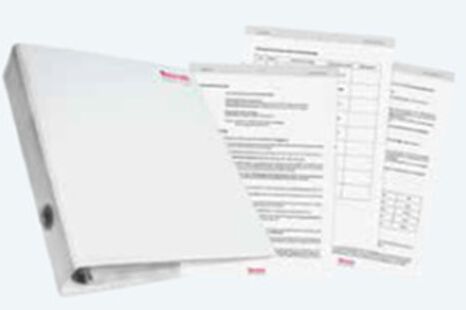Project handbooks: Proportional hydraulics - closed-loop position control

Exercise manuals (1x instructor’s manual and 1x student’s manual)
The exercise manuals are matched to the equipment sets. The equipment sets build on the content and knowledge acquired from the study topics “On/off hydraulics – Manual and electrical actuation (according to BIBB)” and “Continuous valve technology – Proportional hydraulics”. The exercises and tasks described provide basic information and procedures. The layout is uniformly structured and explains how to perform the individual exercises step by step. The content and objectives of this study topic are to familiarise the student with the use of a control valve with onboard electronics, a control unit (cylinder, displacement sensor, counterforce cylinder) and the associated setpoint generator.
Through successful completion of the practical exercises, the student learns about a simple electrohydraulic position control circuit application. This provides practical hands-on training in continuous valve technology.
This “Analog position control circuit” project manual contains exercises that explain hydraulic open- and closed-loop control technology. These exercises are intended to serve as an introduction to practical control technology. This project manual is not intended as a comprehensive guide to the theoretical principles of control technology, but rather to describe the practical application of a simple electrohydraulic position control circuit. It first examines the problem of maintaining position under different loads in the open control loop. This reveals the need for, and the advantages of, a closed-loop control system. The analog controller used here is a relatively simple one that offers only the minimal functionality of a position control system. The lightweight control axes used without mass cannot represent real conditions, of course. But they are well-suited to provide students with an introduction to electrohydraulic control systems. Real electrohydraulic control systems are large, dynamic masses and machines with low natural frequency. The project exercises can be performed with simple equipment.
Course content
Through logically organised, practical exercises, the students will:
- Understand physical laws governing continuous valves such as pressure differential, aperture cross-sectional area and volumetric flow
- Become familiar with and apply regulatory and safety requirements
- Apply the most important symbols of control hydraulics and read schematic diagrams
- Become familiar with and understand the meaning and operation of setpoint (desired) values, ramp functions and signal sequences
- Practise setting, starting up and optimising an electrohydraulic system
- Determine characteristic values and derive characteristic curves from them
- Identify advantages and disadvantages of an open control loop
- Understand the function and significance of the setting of a controller
- Recognise the benefits of a closed-loop control system
- Practise starting up and optimising an electrohydraulic position control system subjected to variable loads.